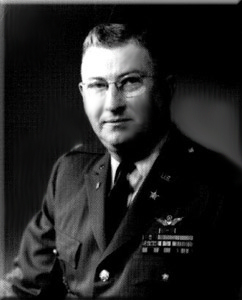
 During the North African campaign, Colonel Charles E. Hart, II Corps artillery officer, thought it prudent to organize Air Observation Post assets with an artillery officer. Lieutenant Delbert L. Bristol joined Hart’s staff. This future Hall of Famer virtually created a position. The energetic aviator organized flight records; assigned missions to planes and pilots; established a system of parts supply to alleviate shortages, picking up the slack from the Army Air Forces which was responsible for same. General George Patton was so impressed that he employed the services of the young pilot to fly him round the front.
During the North African campaign, Colonel Charles E. Hart, II Corps artillery officer, thought it prudent to organize Air Observation Post assets with an artillery officer. Lieutenant Delbert L. Bristol joined Hart’s staff. This future Hall of Famer virtually created a position. The energetic aviator organized flight records; assigned missions to planes and pilots; established a system of parts supply to alleviate shortages, picking up the slack from the Army Air Forces which was responsible for same. General George Patton was so impressed that he employed the services of the young pilot to fly him round the front.
What Bristol did was to bring organization to the business. His attention to detail; energy and organizational skills helped in no small measure to sell the Air Observation Post concept in North Africa. Such was Bristol’s success that he was named artillery air officer of First Army, and, was detailed with planning and organizing much of the Air OP effort for Operation: OVERLORD.(1)(2)
As the artillery air officer for First Army, Major Delbert Bristol’s primary concern for the Normandy landings was to get his planes and pilots across the Channel so as to commence operations. He decided against the LST carriers as used at Sicily. The LST could only launch but not recover aircraft; therefore, was not conducive to continued air operations off shore. However the escort carrier could provide that platform for continued air operations, launching and recovering flivver planes for as long as necessary so as to provide on demand support of Ground Forces ashore. Interesting concept to say the least; dismissed, though, by the Navy which did not want to chance a flattop loitering so close to the beachheads.(3)
Colonel Bristol was inducted into the Army Aviation Hall of Fame in 1976, representing the 1942-1949 period.
Notes:
(1) See page 159, chapter 5, “Initial Deployment and Combat in the North African and Mediterranean Theaters,” Eyes of Artillery: The Origins of Modern U.S. Army Aviation in World War II, by Edgar F. Raines, Jr.; see page 31, chapter six, “Operation Torch and Preparations for Overlord, 8th November 1942-31st January 1944,” The Fighting Grasshoppers, by Ken Wakefield; see pages 38 and 39, “The War Years: North Africa, Sicily, Italy,” Part VI, The Army Aviation Story, by Richard K. Tierney.
(2) Operation: OVERLORD was the Allied codename for the June 6, 1944 Normandy operation.
(3) See pages 66, 67 and 69, chapter 14, “D-Day and the Struggle for Normandy: 6th June 1944-24th July 1944,” The Fighting Grasshoppers, by Ken Wakefield.
Source: Chapter 7, “Grasshopper Infestation,” Vol. 1, Sky Soldiers: The Saga of Army Aviation, unfinished manuscript by Mark Albertson
























